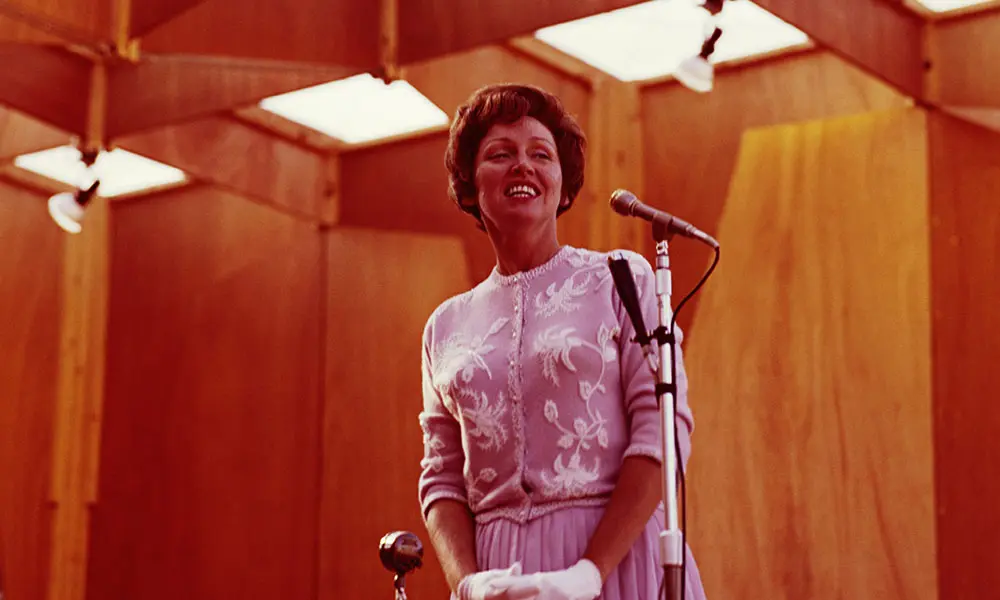
Anita O’Day had one of the most distinctive voices in the history of jazz. O’Day made 16 wonderful albums for Verve Records between 1956 and 1964, but she came to prominence singing with Gene Krupa’s swing band in the early 40s. O’Day’s spectacular appearance at the 1958 Newport Jazz Festival, captured on an award-winning film, made her voice known throughout the world. By the end of her career, she’d worked with some of the greatest jazz stars of the 20th century.
Although her career was occasionally overshadowed by her tumultuous, lurid private life – she was sometimes called “The Jezebel of Jazz” – she is best remembered for her gorgeous vocals. “When I’m singing, I’m happy. I’m doing what I can do and this is my contribution to life,” she once said. Here is our introduction to the best Anita O’Day songs.
Listen to the best Anita O’Day songs on Apple Music and Spotify.
The husky-voiced innovator
Anita O’Day was born Anita Belle Colton in Kansas City on October 18, 1919, the daughter of Irish parents. After joining a Chicago dance troupe as a teenager, she took up singing and adopted the stage name that made her famous. She later revealed that she took the surname O’Day because “in pig Latin that was slang for dough,” and money was something she hoped to get her hands on. One lasting legacy from her childhood was the effects of a surgeon accidentally cutting off her uvula during a tonsillectomy at the age of seven. Without that teardrop-shaped piece of soft tissue, O’Day had difficulty holding long notes. It was something she worked around as she developed her own husky-toned style. “I’m not a singer; I’m a song stylist,” O’Day said in 1989. “I’m not a singer because I have no vibrato. If I want one, I have to shake my head to get it. That’s why I sing so many notes. It’s how I got my style.”
As she showed on her sumptuous versions of “Love for Sale” and “Come Rain or Come Shine” – from the lovely album Anita O’Day Sings Arrangements By Jimmy Giuffre – she became an expert at weaving melodic lines with the lyrics of songs. She also said that she learned the dynamics of what to do with a composition – a technique she always called “shading” – from closely watching Dave Brubeck’s inflections on the piano when he was a house musician at the Black Hawk nightclub in San Francisco.
It is no surprise that one of her main vocal inspirations was Billie Holiday. Like the singer famously known as “Lady Day,” O’Day was also able to bend and stretch lyrics in a sensual way. O’Day once said that the most enjoyable album she ever made was 1961’s Trav’lin’ Light, a tribute album to her idol Holiday. The record, which includes a sparkling version of “Miss Brown to You,” featuring Ben Webster on tenor saxophone, showed off her remarkable sca’ singing skills, something she later explored on songs such as “Them There Eyes,” recorded with Oscar Peterson and guitarist Herb Ellis in 1957.
Happily, even 21st-century music fans can enjoy footage of O’Day’s stage prowess by watching the celebrated documentary Jazz on a Summer’s Day. O’Day, sporting white gloves, a black-and-white dress, and a matching wide-brimmed hat, was assured and charismatic as she reinvented “Sweet Georgia Brown” with effortless vocal agility. “The film made me a star singer in Japan and paved the way for international tours,” O’Day once recalled.
The perfect voice for jazz bands
“She was a wild chick, all right, but how she could sing,” drummer Gene Krupa said of O’Day. After falling out with Benny Goodman, who didn’t like the way she improvised, O’Day joined up with Krupa’s band in 1941. Although she had a fractious personal relationship with trumpeter Roy Eldridge, they blended musically in a special way. Their duet “Let Me Off Uptown” provided Krupa with his first big hit as a bandleader. The track features a scintillating trumpet solo, just after O’Day urges him to “blow, Roy, blow.” Krupa’s band produced a score of great songs, including “Opus One.” O’Day later described the thrill of mixing with Krupa’s celebrity friends such as actress Lana Turner. “Onstage it was a team, and it was very nice. In fact, the 1940’s were the best time of my life,” she recalled.
O’Day was later able to pick top jazz sidemen for her solo projects, including saxophonist Zoot Sims. In 1961, he played on a version of Horace Silver’s “Señor Blues” for the Verve album All the Sad Young Men. A year later, she showed her boldness by picking innovative backing musicians when she recorded with the Latin and bop-grounded quartet of vibraphonist Cal Tjader, for the Verve Records album Time for 2. One of the highlights was her interpretation of Dave Frishberg’s satirical classic “Peel Me a Grape,” a song later covered by Blossom Dearie. O’Day and Tjader also did a sweet Latin-infused version of “Mr. Sandman.”
One of her go-to accompanists in the 50s and 60s was guitarist Barney Kessel who played on five of her Verve albums. On the 1958 album featuring the pair, Anita Sings the Winners, O’Day sang a joyful version of “Peanut Vendor,” a song recorded by Louis Armstrong. O’Day was a huge fan of the trumpeter and described jamming with Armstrong and flautist Herbie Mann in Madison Square Garden in 1963 as one of the most enjoyable moments of her career.
A picker of fantastic songs
Anita O’Day was one of the most imaginative interpreters of the Great American Songbook. Her dreamy version of “A Nightingale Sang in Berkeley Square”, written in 1939 by Manning Sherwin and Eric Maschwitz, features some slick orchestration by Buddy Bregman. Another treat, from O’Day’s 1956 Verve album Pick Yourself Up With Anita O’Day, is her interpretation of the Johnny Mercer tune “I’m With You.” Two other notable top-class covers are her versions of Fats Waller’s “Honeysuckle Rose” and Billy Strayhorn’s “Take the ‘A’ Train.”
As well as covering classics by leading male lyricists, O’Day was always delighted to showcase female songwriting talent. She particularly rated Bernice Petkere, a woman described by Irving Berlin as “Queen of Tin Pan Alley.” On her 1953 Verve album Collates, O’Day reunited with trumpeter Eldridge for a haunting version of Petkere’s “Lullaby of the Leaves.”
A tumultuous life
Anita O’Day lived a tumultuous and painful life. She sometimes poured her melancholy into moving versions of mournful songs, including her version of the country music classic “Tennessee Waltz,” which was a hit for Decca Records when she cut it with Jack Pleis’s Orchestra in 1951. She also had a hit with “And Her Tears Flowed Like Wine” a year later, when she recorded a version with Stan Kenton’s Orchestra. It was around this time that O’Day’s personal life began to spiral out of control. The singer had served time in prison in the 40s for possession of marijuana, and by 1954, she had fallen into what she called “the quicksand” of heroin addiction.
In her gripping, candid 1981 memoir, High Times Hard Times, O’Day recalled her spell in prison for using heroin and how, in 1969, she came perilously close to dying from an overdose. “All the people from years back, they were all on dope,” she said.
O’Day also had a troubled love life. Her first marriage to Don Carter was annulled and a second, to Carl Hoff, was dissolved. She channeled her emotional despair into her music and among her most affecting songs are her searing versions of heartbreak ballads such as “You Don’t Know What Love Is” and her own co-written composition “Waiter, Make Mine Blues.”
Larger-than-life personality
One of Anita O’Day’s most popular tunes was “Tea for Two.” As well as performing Vincent Youmans and Irving Caesar’s 1924 classic during her Jazz on a Summer’s Day performance, she also recorded a fast-paced version for her brilliant live album Anita O’Day at Mister Kelly’s, recorded for Verve in Chicago in 1958.
O’Day was recognized for her ability to command a stage, and she refused to conform to the stereotypes of how female big-band singers were supposed to look. She wore jackets and pinstripe suits instead of strapless evening gowns. Her vivacious personality also attracted the attention of Hollywood. She had a cameo role in the Robert Duvall/Karen Black film The Outfit and also starred in the 1970 film Zig Zag, which featured a score by Oliver Nelson. In 2007, a year after her death at the age of 87, she was the subject of director Robbie Cavolina’s biopic Anita O’Day: The Life of a Jazz Singer. “I asked Anita one day, what jazz is and she said, ‘it is having the ability to improvise, make it up as you go, and to be good at it’,” said Cavolina. “She lived her life one hundred percent for music.”
In late 1996, the year she received a lifetime achievement award from the National Endowment for the Arts, O’Day fell down the stairs of her Californian home after a drinking binge and broke her arms. “The Scotch did me in,” she admitted with characteristic candor. Even so, she bounced back and continued singing for the next decade. Fans who saw her near the end, performing in Hollywood’s Vine Street Bar & Grill, praised her magnificent versions of Duke Ellington songs. “In this world, you’ve only got what you give away,” said O’Day, “and that’s what I do: I give myself to my audience.”
Think we missed one of Anita O’Day’s best songs? Let us know in the comments below.
source https://www.udiscovermusic.com/stories/anita-oday-best-songs/

